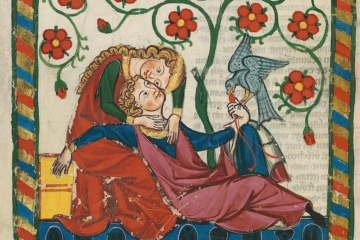by Harry Gulcher, Master of History in Rosewood
After Charlemagne was crowned as the Roman Emperor by Pope Leo III on Christmas, the year 800, the Roman Empire, or as Pope Alexander I called it, the Holy Roman Empire, or Sacrum Imperium Romanum, spanned from the Atlantic to the Germanic lands. It was the successor to the fallen western Roman empire.
Wars and succession crises destroyed the Empire, by the year 1000 its authority was nothing. It was only in recent times, as early as 1095 that the idea to restore the Empire was brought during a meeting of the highest nobility in the Germanic lands.
Power corrupts, and so too did it corrupt any attempt at establishing a new Empire in any peaceful way. The two regional powers, Saxony and Bohemia both formed factions where they claimed overlordship over the lands of the Roman Empire. War could not be averted any longer, and on the 13th February 1100, 300 years after the Holy Roman Empire was founded, Bohemia declared war on Saxony, a war for the Imperial throne.
The Saxons enlisted the aid of the supporters, Bavaria, Thuringia, and Magdeburg, while Austria, Brandenburg, Bamberg, and the Obotrites stepped in to support Bohemia. Their armies numbered around 10.000 each.
The Battle of Magdeburg, 4th April 1100
Brandenburg decided to try and forcefully gain territory during the conflict and invaded its weakest enemy, Magdeburg. Of course, Magdeburg’s force of 600 could not withstand Brandenburg’s 1.900. It was a decisive victory and Magdeburg’s army was totaled. None remained.
The Battle of Bamberg, 12th Arpil 1100
Bavaria, like Brandenburg, decided to go after its weakest neighbor and attacked Bamberg on the 12th April. Oddly enough, the odds were similar to the Battle of Magdeburg. 1.900 Bavarians faced off against 800 defenders. However, it would seem God favored the Bambergians, for he granted them a hard-fought victory. Bamberg had prepared for an invasion by Bavaria, and therefore they waited for the perfect opportunity to stage a battle and draw their force into a slaughter. Bamberg used hilly terrain and its neighboring forts to lock the Bavarians in a tight space where their numbers would make no difference. The Bavarians’ hubris was their reliance on numbers, which Bamberg turned into a major weakness and flaw in their tactics. The 800 of Bamberg will be remembered for losing only 90 men and managing to slay 960 Bavarians, causing an additional 200 to route and flee the battle. The smallest ally of Bohemia proved valuable for they basically disabled the Bavarian threat in central Germania.
The Siege of Nuremberg, 16th May 1100
The Austrian troops move in to secure the opening granted to them by the Bambergians. They besiege a major point in Bavaria and lose only 52 men in the process. Nuremberg fell after 27 days. The surrenders did not expect the Austrians to reach them in such short notice so their food supplies were not properly stocked.
The Battle of Berlin, 23rd Spetember 1100
Back to the north, the Saxon army unites and retaliates against Brandenburg’s attack on Magdeburg. Their march is left unchecked all the way to Berlin, where they do battle with Brandenburg aided by the Obotrites. The Saxons were able to snatch a victory. They lost 850 and 200, while Brandenburg lost 1.750 and 400. Instead of sieging Berlin, the Saxons would continue a steady advance towards Bohemia, perhaps even to aid their ally, Bavaria.
The Battle of Würtzburg, 27th December 1100
Before settling down to wait out the winter, Austria pushed a final push towards the retreating Bavarian army. They caught up to them and attacked. The 1.500 strong Austrians managed to kill every single one of the 750 Bavarian soldiers. Bavaria could only last a few weeks before surrendering. The King of Bavaria signed a peace on the 16th January 1101. After seeing Bavaria surrender and lose so many men and resources, the relatively inactive Thuringia decided to not engage any further and signed a white peace on the 17th, just one day later. Magdeburg followed suit and sued for peace on the 10th March 1101.
The Battle of Leipzig, 22nd May 1101
After a long winter, the Saxon army continued its march southward and finally met with Bohemia’s forces. Saxony, despite being outnumbered, beat back the Bohemians and earned a good head start during its march to Berlin. Saxony lost 350 and 50, while Bohemia lost 450 and 200.
The Siege of Berlin, 7th June 1101
The Saxon force marched until they reached the gates of Berlin and laid it under siege. After 20 days the siege was broken by the Bohemian army, which had returned for round two. The Saxons lost 329 men in vain, but now they need to face their greatest threat. This battle would decide the fate of Europe.
The Second Battle of Berlin, 28th June 1101
Crushed against the walls and under pressure from a superior and unified army, Saxony lost the battle and tipped the scales of war in Bohemia’s favor. Saxony lost 1.260 and 500, while Bohemia lost 1.340 and 200. Saxony’s army fell to insubordination and went on a campaign of its own, disregarding the King’s wishes. He essentially had a rouge army within his lands, which only served to cause unrest in the west, where resentment grew towards the monarch.
The Siege of Hanover, 28th July 1101
The King was not ready to give up just yet, and would rather his people starve than admit defeat. When the Bohemians came with an army, he refused to surrender and so a 277-day long siege began that day. After the city fell and the King of Saxony, Magnus I, was imprisoned, he had no other choice but to surrender his claim to the Holy Roman Empire. Magnus I, surrendered on the 13th October 1102.
Novum Sacrum Imperium Romanum
After his victory, King Vratislaus II summoned a diet of all lords and ladies of the Germanic and Italian lands. Some 300-500 turned up, including the Germanic Pope, Clement II. This seemed to be the rise of the Germanic peoples in Europe. It would seem that neither the Frankish Kings, nor the Byzantine Emperors were the successors of Rome, but it was in fact the Germans.
Symbolically, King Vratislaus II was crowned Kaiser of the New Holy Roman Empire, but the Pope on the 25th December 1102.
Kaiser Vratislaus II, demanded the fealty of every Germanic ruler from the Sirius Empire to Poland and from Denmark, to Italia. While under the Pope’s influence, a few Italian rulers and bishops joined the Empire, including the Papal state, which now played a huge role in both the formation and further development of the interesting new entity in Europe.
It was decided that the Emperors would be elected by seven Prince-Electors, the strongest and most influential nations under the banner of the NHRE. The Prince-Electors are the rulers of:
1. Bohemia
2. Saxony
3. Austria
4. Brandenburg
5. Bavaria
6. Carinthia
7. Trier
Upon an Emperor’s death, the Electors will choose a new one. The Emperor can be from the NHRE or outside, one of the only requirements is that he be a Christian. The Kaiser’s duty is to defend the lands of the NHRE and to uphold the values of the Roman Church.
The reemergence of the Holy Roman Empire in Europe will serve as a dividing line between Western and Eastern Europe, in both a political and religious sense. Europe is home to many an Empire, but the New Holy Roman Empire seems to be the largest and strongest, but its interworkings are an enigma to most. We live in an era of change, and the Golden Phoenix’s rise is the culmination of all this change. Finally someone can challenge Byzantium for the title of Rome’s successor.


